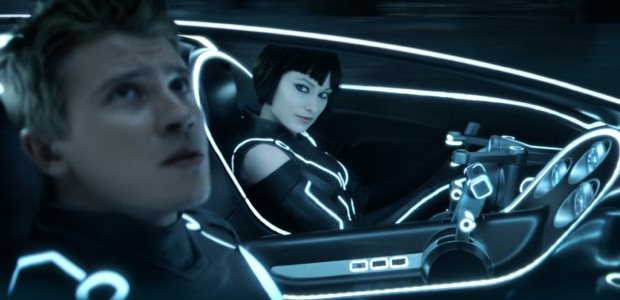Right from the distinct 3D Disney logo at the start, Tron: Legacy is a visually striking film. As depicted in posters and trailers, it has a dazzling, pulsating vibe that relies heavily on CGI – which is apt considering how much of the story takes place inside a digital world. Director Joseph Kosinski marks his feature film debut by making full use of his past experiences, having made equally striking television commercials. Tron: Legacy, therefore, works best for its action, and somewhat less for its story or drama.
The movie begins a few years after the story of the original Tron ended. It’s 1989 and Kevin Flynn (Jeff Bridges), CEO of ENCOM International, tells his son Sam about a new technological breakthrough he has discovered while working on “The Grid”, promising to take him there one day. That night he disappears, never to be seen again. Presumed to be dead, ENCOM is taken over by its Board of Directors. Cut to twenty years later and Sam Flynn (Garrett Hedlund), now 27, inadvertently finds himself transported into the Grid, which he discovers to be a digital world that exists within the mainframe of ENCOM. He learns that his father has been trapped here for the past two decades, while CLU, a program that Kevin had created in his likeness, rules the Grid.
Tron: Legacy is hardly original – it takes inspirations from many movies – but its charm is in the way these elements are combined. The center-piece of the film, the games arena sequence, is a massive upgrade of a similar scene from the original Tron. Gorgeously rendered, the light-cycle battle is set in an arena with multiple levels, transparent floors and ten bikes competing for survival. Body-suits with funky neon lights, a dark world with high-contrast, back-lit luminosity and a techno-heavy soundtrack by Daft Punk make the Grid look very cool. Garrett Hedlund, as the lead, helps the film in no small part, performing his role with a youthful but suave machismo. As Sam he is confident, but not cocky.Jeff Bridges as the aging Kevin Flynn and digitally de-aged in post-production to play the younger CLU, is amusing in both roles.
Most (though not all) of Tron: Legacy is in 3D, primarily those scenes set within the digital world, and because they were shot in 3D, the result on screen is quite effective. It is to the director and Disney’s credit for not exploiting the technology – the 3D scenes are not manipulative (no objects deliberately poking outwards from the screen), and more importantly, the scenes shot in 2D have not been digitally converted to shoddy 3D in post-process either, hence freeing the film from the burden that many 3D live-action movies that have been converted seem to carry. Ironically, this also means that the movie can be enjoyed in regular 2D screens without losing out on the experience.
For fans of the original, there may be much amiss here. The Grid, as defined in the original movie, has been modified in structure and idea. Other thoughts have been left open-ended, and the in-world mythology has been somewhat re-developed. Thus, while Tron: Legacy is a sequel, it functions better as a stand-alone film, though one that may spawn future sequels.
Rating: 




